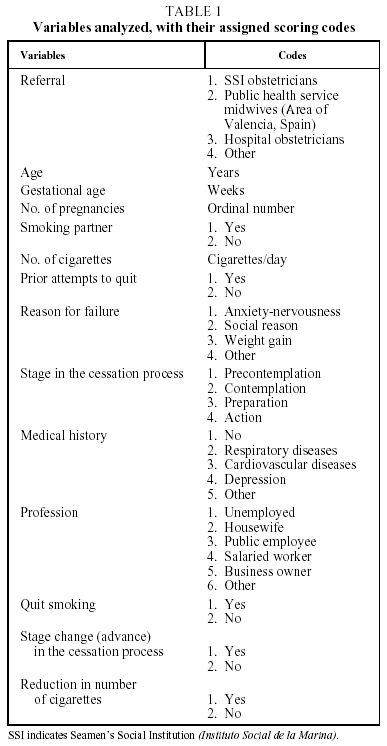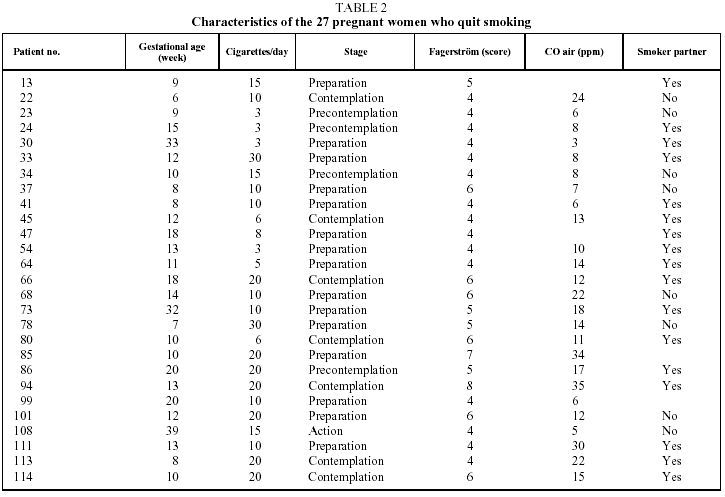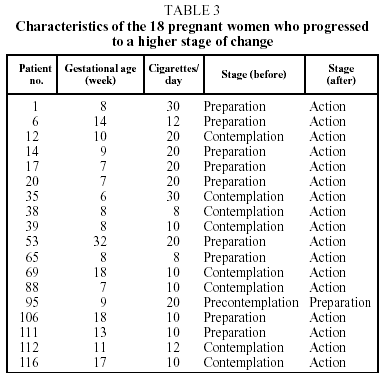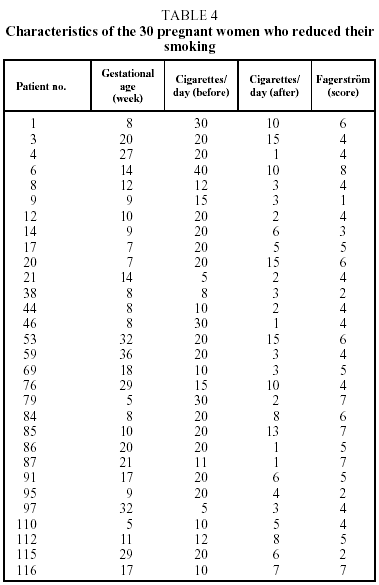Introduction
Smoking is the leading cause of preventable death and disability in most developed countries.1 Pregnancy is a time during which health care is of special concern and theoretically should provide strong motivation for a woman to quit. Nevertheless, in spite of the health risk smoking poses for children, the intention to quit has not been found to be significantly different in pregnant and nonpregnant smokers,2 and it is striking that a high percentage of pregnant women smoke while only a small percentage quit during pregnancy.3
A Spanish study found that the prevalence of smoking at the start of pregnancy was 58% and that only a third of those women quit while pregnant.4 Moreover, 24% had received no recommendation to quit from their doctors.
Research has shown that a fetus is exposed to the smoke from a mother´s cigarettes. Jordanov,5 for example, found that the amniotic fluid concentration of cotinine, a metabolite of nicotine, is 8-fold higher in smokers than in non-smokers.
A mother´s smoking during pregnancy can affect the health of her future child in a variety of ways,6 in particular by increasing the likelihood of respiratory or otorhinolaryngological problems or of premature death.7 The prevalences of asthma and symptomatic asthma are higher among children exposed to maternal smoking during gestation than among unexposed children,8 with odds ratios (OR) of 1.8 and 2.3, respectively,9 , such that removing intrauterine exposure to maternal smoking could prevent between 5% and 15% of asthma cases in children.9
An interesting Danish study enrolling 25 102 children showed that intrauterine exposure to smoking doubled the risk of stillbirth (OR=2) and increased infant mortality in the first year of life (OR=1.8).10 The risk for children of women who quit smoking during the first trimester of pregnancy was fortunately similar to that of children of nonsmokers, such that if all pregnant smokers quit before the 16th week, 25% of all stillbirths and 20% of first-year infant deaths would be avoided. It is therefore possible to reduce infant mortality by implementing interventions designed to reduce the number of pregnant smokers, and such an undertaking should be an authentic public health priority in our opinion.
A doctor´s advice to quit smoking is one of the most cost-effective interventions available.11 One multicenter study showed that a minimal intervention tailored to a patient´s stage in the cessation process gave good results in terms of both successful abstinence and progress to a higher stage of change.12 Nevertheless, such counseling is not usually given.13
In the case of pregnant smokers, the administration of the usual pharmacological aids are formally contraindicated14 and personally tailored medical counseling should therefore have an important place in the therapeutic armamentarium. Such counseling has hardly been studied in Spain, however, and to our knowledge its specific application by physicians specially trained in smoking dependence has never been considered.
We performed an open observational study of care given to a group of pregnant smokers by respiratory medicine specialists trained in smoking addiction, with the aim of identifying the characteristics of dependence among pregnant women in Spain, to assess the efficacy of medical counseling tailored to a patient´s stage in the cessation process, and to analyze factors that might influence the ability to quit smoking during pregnancy.
Material and methods
Patients
All pregnant smokers receiving obstetric care at 4 clinics in Area 4 of the Valencian Autonomous Community between September 1, 2001 and March 31, 2002 were enrolled. The women were referred by an obstetrician or midwife because of an inability to quit smoking after having been advised to do so. The following protocol was applied when treating each woman:
1. Medical history. Data related to the history of smoking dependence were gathered (age when smoking started, number of cigarettes per day, presence or not of a smoker partner, previous attempts to quit, and reasons for failure), along with other patient characteristics (gestational age, profession, previous illnesses).
2. Diagnosis of stage of change in the cessation process. Stage diagnosis was performed using the method recommended by the Spanish Society of Pulmonology and Thoracic Surgery (SEPAR).15
3. Evaluation of level of nicotine dependence by means of a modified Fagerström test.15
4. Measurement of expired air carbon monoxide (CO) levels. A Micro-Smokerlyzer (Bedfont Technical Instruments Ltd, Kent, UK) CO-oximeter was used. The patient exhaled slowly into the mouthpiece of the CO-oximeter 15 seconds after having taken a deep breath.
5. Treatment. Smokers in the precontemplation stage were given literature explaining the health risks that smoking posed for the child in terms of morbidity and mortality and the benefits to be derived from quitting. This literature included a summary of 2 reviews of the topic that had recently been published in Spanish.6,16 Smokers in the contemplation phase were given the same literature plus a practical guide organized around 10 steps for quitting smoking developed by the Smoking Addiction Assembly of SEPAR.15 Smokers in the preparation or action stage were additionally helped to decide the first "nonsmoking" day. For women in the precontemplation stage, both the brochure and the doctor´s counseling emphasized information about smoking dependence (about risks, but especially about the benefits for the child when the mother quits), whereas for women in the contemplation stage, counseling targeted increasing their confidence to try again to quit and teaching them to reach positive conclusions about past failed attempts.12
6. Follow-up. All the pregnant smokers were followed for 3 months. The first visit took place during the first month of the intervention. Information about current smoking was taken from each patient and changes in cessation stage were assessed at each visit. Expired air CO was also measured.
7. Data analysis. The outcome was assessed from 2 points of view: a) efficacy of the intervention for treating pregnant smokers, and b) benefit of the intervention on influencing the process of smoking cessation or reduction of the intensity of smoking.
A pregnant woman was considered a smoker if she smoked 1 or more cigarettes per day and/or her concentrations of expired air CO were over 10 ppm and/or she did not come to follow-up visits. The patient was considered a nonsmoker if an expired air CO-oximeter reading of 10 ppm or lower confirmed her declaration of abstinence.
Statistical analysis
Table 1 shows the data collection sheet and codes assigned to variables. Answers were scored according to their nature, such that quantitative data were recorded using real numbers and qualitative data were assigned numbers reflecting categories.
Spearman's rank correlation coefficient (ρ) was calculated to assess the relation between the treatment outcome and each other variable in order to determine the patient features or other factors associated with a positive response to the intervention (quitting or benefiting from the intervention).17
Descriptive statistics were reported as means (SD) and ranges for quantitative variables and as the number of subjects in each category and percentages for qualitative variables. Statistical significance was set at .05.
All calculations were performed on a Toshiba Satellite 1900-102 personal computer using the SPSS (version 10.0) package for Windows.
Results
Patient characteristics
One hundred sixteen women with a mean age of 29.71 (5.44) years (range 15-41 years) were treated. Mean gestational age was 15.13 (9.10) weeks (range 4-39 weeks) and age of onset of smoking was 15.18 (2.34) years (range 9-28 years). Most of the women (76.5%) had begun smoking by age 16 years. The mean number of cigarettes smoked was 15.35 (8.16) (range 2-45). Smoking fewer than 10 cigarettes per day was reported by 18.1%. Expired air CO was 15.11 (7.51) ppm (range 4-35 ppm).
The score for physical dependence on nicotine (modified Fagerström test) was 4.01 (2.21) points (range 0-10); 45 women (38.8%) had scores less than 4, and 71 (61.2%) had scores of 4 or more. Seventeen (15%) of the latter had scores indicating high physical dependence on nicotine (7 or higher).
Seventy-three women (62.9%) were experiencing their first pregnancy and 43 (37.1%) had had 1 or more prior pregnancies.
Sixty-nine women (59.5%) had tried to quit smoking previously. Among the reasons for relapse were symptoms consistent with abstinence syndrome in 33 (48.5%), and social pressures in 21 (31%). Fourteen (21%) mentioned other reasons. It is noteworthy that none of the women in this series mentioned weight gain as the reason for relapse.
Seventy-three (62.9%) reported no prior disease, 10 (8.6%) reported respiratory diseases such as asthma or pneumonia, 1 (0.86%) had cardiovascular disease, 4 (3.4%) had experienced depression, and 28 (24.1%) had other diseases.
Eight women (6.9%) were unemployed, 23 (19.8%) were housewives, 65 (56%) were salaried workers, 6 (5.2%) had their own business and 14 (12%) had other professions or situations (students, etc.).
Eighty-seven (75%) reported having a husband or partner who smoked and 21 (18.12%) a partner who did not; this information was unavailable for 8 women (6.9%).
Forty-nine women (42.2%) were in the precontemplation stage, 29 (25%) in contemplation, and 38 (32.2%) in preparation or action stages. Thus, 78 women (67.8%) were not intending to quit smoking during the first trimester of their pregnancies.
Efficacy of the program
In the visit that took place between 1 and 3 months of the first visit, 27 women (23.3%) had quit smoking, 71 (61.2%) had not, and 18 (15.5%) did not come to the appointment. Assuming that the women who did not come to the appointment did not quit smoking, 89 women were still smokers.
Among the 71 women who had not quit and came to their appointments, 18 (25.4%) progressed to a higher stage in the cessation process (20.2% of all those assumed to still be smoking).
Thirty (42.2%) of the 71 women who came to their appointments and who had not quit had reduced their smoking (33.7% of all those assumed to still be smoking).
Overall, benefit from the program, understood as its impact on quitting, on reducing the number of cigarettes smoked, or on progressing to a higher stage of change was observed for 60 women (51.7%) in comparison with 56 women (48.3%) who did not quit, reduce smoking, or advance a stage in the cessation process.
Tables 2 through 4 show the characteristics of women who quit smoking, changed stage or reduced their smoking, respectively.
Factors related to program success
Quitting was significantly related to, or tended to be related to, the following variables: number of pregnancies (ρ=0.194; P=.056); age at onset of smoking (ρ=-0.193; P=.059); smoker partner (ρ=-0.186; P=.076); and stage in the cessation process (ρ=-0.294; P=.003), with greater likelihood of success among women in the preparation or action stages.
Benefiting from the program was significantly related to, or tended to be related to, the following variables: age (ρ=-0.187; P=.044), with greater likelihood of success among older women; age at onset of smoking (ρ=-0.164; P=.079); and stage of change in the cessation process (ρ=-0.325; P=.000), with greater likelihood of success among women in the preparation or action stages.
Discussion
Smoking during pregnancy is the single most important modifiable risk factor for morbidity and mortality related to pregnancy in developed countries because it doubles the probability that a child will die at birth or before the age of 1 year7,10 and increases the likelihood that a child will develop certain diseases, most of which are respiratory8 or otorhinolaryngological.18 Fortunately, risk for the children of women who quit smoking before the 16th week of pregnancy is similar to that of the children of nonsmokers.10 The problem is therefore a serious one and intervention is absolutely necessary.
Pregnant smokers make up a special subpopulation of female smokers. Because smoking can affect both the mother and her future child, women can be expected to be highly motivated to quit during pregnancy. Nevertheless, several studies have found only modest changes in smoking during pregnancy.19, 20
An interesting study in 33 states in the United States of America demonstrated that the prevalence of smoking decreased similarly among both pregnant women (from 16.3% to 11.8%) and nonpregnant women (from 26.7% to 23.6%) between 1987 and 1996.21 Surprisingly, the decrease among pregnant women was mainly due to an overall reduction in the rate of new smokers among young women rather than to an increase in the rate of cessation related to pregnancy.
The figures for Spain are discouraging. A study performed in the Spanish Autonomous Community of Valencia found that 62% of women who gave birth smoked before pregnancy and 28% of them quit spontaneously.22 Giving up smoking during pregnancy was more frequent among women who were older (OR=2.1), had more education (OR=2.6), or smoked less than heavy smokers (19 cigarettes/day, OR=12.3; vs 10-19 cigarettes/day; OR=2.7). The women enrolled in the present study had not quit spontaneously; nor had they followed the initial advice of their midwives or obstetricians. For that reason they were referred to our service for diagnosis and tailored treatment of their dependence.
The present study brings out the complexity of the intervention, given the characteristics of the pregnant women who smoked and who had not followed recommendations to quit. A high percentage of them (61.2%) scored over 4 points on the Fagerström test and over half (59.5%) had tried to stop smoking previously, with relapses mainly attributed to abstinence syndrome. Moreover, 67.8% had no intention of quitting in the short term and only 18.1% were smokers of fewer than 10 cigarettes per day.
The most important benefits accrue when a woman quits in the first trimester,10 such that interventions should be most intensive during that period. We therefore analyzed results at 3 months, even though all pregnant smokers were enrolled regardless of gestational age, a factor which was not significantly related to success or failure of the program. Later studies are planned to monitor the progress of women who were motivated but who failed to quit.
The present program based on individually tailored medical counseling given by pneumologists with training in smoking addiction was effective: 27 women quit smoking entirely and the program benefited 33 other women who reduced the intensity of their smoking (with benefits for mother and child), and/or progressed a stage in the cessation process and therefore increased the likelihood of quitting later. Among such women, new interventions may increase the success rate, either during pregnancy or later.
Fifty-six women (48.3%), however, did not benefit from treatment. This was the case for young women, particularly, or for those who were in the precontemplation stage. It therefore seems necessary to design new programs with the characteristics of those women in mind.
The main objective of the intervention was to eliminate smoking among pregnant women. Nevertheless, those who smoked less or who progressed a stage in the cessation process also benefited, as suggested by a recent study by England et al,23 who found that reducing smoking by at least 8 cigarettes/day was associated with increased birth weight.
We were interested in knowing the effect of a partner's smoking on a pregnant woman´s habits, given that if the influence proved negative, the program would need to be extended to the couple. An interesting Spanish study by Jané et al24 recently analyzed the factors affecting a woman´s quitting during pregnancy, finding that the probability that a woman would quit increased if her partner did not smoke (OR=1.78).
In our study, a smoker partner was present in 75% of cases, a higher prevalence than that in the Spanish population overall.25 Although this variable tended to be associated with poor response to the intervention (Spearman's ρ), it did not reach statistical significance, probably due to the small sample size. Spearman's ρ is a variation of the Pearson product moment correlation that assigns limits to ordinal values as opposed to measuring the degree of linear correlation between the data themselves.17
Economically speaking, the cost of smoking during pregnancy is high. Miller et al26 estimated that the sum of additional costs attributable to smoking in the first year of life ranged between US $1142 and $1358 for every pregnant smoker. More recently, Adams et al27 estimated additional neonatal costs to be around US $700 for smoker mothers, such that neonatal costs attributable to smoking in the United States of America represented nearly $636 million in 1996.
Smoking is now considered a chronic disease that requires an appropriate diagnostic and therapeutic approach. In keeping with SEPAR guidelines,15 treatment for smokers is currently based on both individually tailored medical advice with psychological support and pharmacological aids (nicotine replacement therapy and bupropion). The safety of drug treatment has not been firmly established for pregnant women, however.
Nicotine replacement therapy is considered contraindicated for these patients in Spain, according to drug packaging inserts. The US Food and Drug Administration, however, while initially including nicotine gum in category X (unacceptable risk for the fetus; not to be used during pregnancy), changed that classification in 1992 to category C (no controlled studies have been done in women; only to be used if benefit exceeds risk). The remaining formulations are placed in category D (risk for the fetus, but benefit may exceed risk).14
Animal experiments indicate that nicotine adversely affects fetal central nervous system development and its effects on the brain may be implicated in the pathophysiology of sudden infant death syndrome.28 Nevertheless, it is unlikely that the toxicity of smoking during pregnancy is exclusively related to nicotine, such that nicotine replacement therapy might theoretically be less prejudicial than continuing to smoke. In any case, as some authors have pointed out, it seems necessary to continue studying this question.28
For bupropion, data are not yet available on effects during pregnancy, and its use is therefore formally contraindicated.29
In conclusion, smoking during pregnancy constitutes an important public health problem. Our study demonstrates the need for intervention by specialists trained in smoking addiction to facilitate the cessation process among most women who smoke during pregnancy.
Acknowledgments
The authors express their gratitude to the obstetricians of the Seamen´s Social Institution (Instituto Social de la Marina) of Valencia, Spain, for their cooperation and confidence in referring patients.
This study was funded by the public health authorities of the autonomous regional government of Valencia, Spain (Dirección General para la Salud Pública de la Generalitat Valenciana).
Correspondence: Dr F. Carrión Valero.
Servicio de Neumología. Hospital Clínico Universitario.
Avda. Blasco Ibáñez, 17. 46010 Valencia. Spain.
E-mail: fcava@eresmas.com
Manuscript received November 25, 2002.
Accepted for publication February 19, 2003.

















